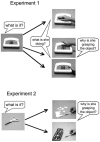Intention understanding in autism
- PMID: 19440332
- PMCID: PMC2680029
- DOI: 10.1371/journal.pone.0005596
Intention understanding in autism
Erratum in
- PLoS One. 2009;4(6). doi: 10.1371/annotation/3f865d29-8d14-4f15-86dc-061631ff6d78
Abstract
When we observe a motor act (e.g. grasping a cup) done by another individual, we extract, according to how the motor act is performed and its context, two types of information: the goal (grasping) and the intention underlying it (e.g. grasping for drinking). Here we examined whether children with autistic spectrum disorder (ASD) are able to understand these two aspects of motor acts. Two experiments were carried out. In the first, one group of high-functioning children with ASD and one of typically developing (TD) children were presented with pictures showing hand-object interactions and asked what the individual was doing and why. In half of the "why" trials the observed grip was congruent with the function of the object ("why-use" trials), in the other half it corresponded to the grip typically used to move that object ("why-place" trials). The results showed that children with ASD have no difficulties in reporting the goals of individual motor acts. In contrast they made several errors in the why task with all errors occurring in the "why-place" trials. In the second experiment the same two groups of children saw pictures showing a hand-grip congruent with the object use, but within a context suggesting either the use of the object or its placement into a container. Here children with ASD performed as TD children, correctly indicating the agent's intention. In conclusion, our data show that understanding others' intentions can occur in two ways: by relying on motor information derived from the hand-object interaction, and by using functional information derived from the object's standard use. Children with ASD have no deficit in the second type of understanding, while they have difficulties in understanding others' intentions when they have to rely exclusively on motor cues.
Conflict of interest statement
Figures



References
-
- American Psychiatric Association. Diagnostic and statistical manual of mental disorders, 4th edition, (DSM-IV) Washington, DC: Author; 1994.
-
- Kanner L. Autistic disturbances of affective contact. Nervous Child. 1943;2:217–250. - PubMed
-
- Hobson RP. Autism and the development of mind. Hillsdale (NJ): Lawrence Erlbaum Associates; 1993. p. 246.
-
- Frith U. Autism. Explaining the enigma. 2 ed. Oxford: Blackwell Publishing; 2003. p. 249.
-
- Brambilla P, Hardan A, di Nemi SU, Perez J, Soares JC, et al. Brain anatomy and development in autism: review of structural MRI studies. Brain Res Bull. 2003;61:557–569. - PubMed

